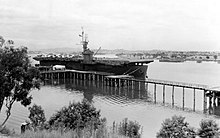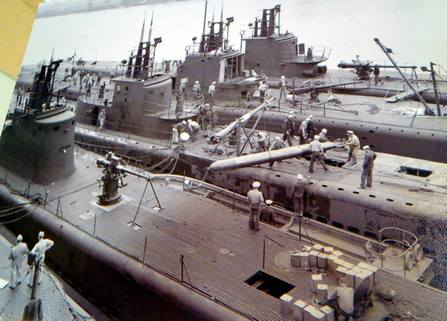
The U.S. 7th Fleet holds a significant place in history, particularly during World War II. Established on March 15, 1943, in Brisbane, Australia, it was a crucial component of the Allied forces in the Pacific theater. Under the leadership of Admiral Arthur S. “Chips” Carpender, the fleet played a pivotal role in the South West Pacific Area (SWPA), operating under the command of General Douglas MacArthur. They were known as “MacArthur’s Navy”. Its General Headquarters (GHQ) – Southwest Pacific Area was based in the (former) AMP building, corner Queen and Edward street.
The initial fleet consisted of the cruisers USS Minneapolis and USS New Orleans, and four destroyers. It also did include a number of Dutch vessels. As much of 30% of the destroyers were Dutch ships. Furthermore nearly all its transport ships came from the Dutch Merchant Navy.
During its deployment, the Seventh Fleet saw action in various Pacific campaigns, contributing to key engagements and operations. One notable example was its participation in the Battle of Leyte Gulf, recognized as the largest naval battle in history. Led by Admiral Thomas C. Kinkaid, the fleet played a significant role in pivotal moments of the battle, including the Battle of Surigao Strait and the Battle off Samar.

Camp Seabee, also known as U.S. Naval Construction Battalion Detachment (NCBD) Brisbane at Eagle Farm, served as a base for the Seabees, the United States Naval ,Construction Battalions. It served as a logistics and support base for the Seabees who were deployed in the Pacific Theatre. The Seabees were responsible for constructing and repairing naval and military facilities, including airfields, piers, bridges, and other infrastructure, in areas where U.S. forces were engaged in combat.
There was also a US submarine Base at New Farm wharf where the US Navy’s submarine tender Fulton was moored. ‘During World War II, 79 US subs operated out of Brisbane, sinking over 100 enemy ships, supporting coast watchers, carrying out rescues and training local forces. Seven Brisbane-based US submarines with their 426 crewmen were lost.’
Aside from its military engagements, the presence of the Seventh Fleet left a lasting impact on Brisbane. The construction of the US 7th Fleet Officers’ Club in 1943 stands as a testament to its influence. Initially built as the 7th Fleet’s Officer’s Mess for its New Farm submarine base, the club quickly became a popular entertainment venue. With access to American luxuries and regular dances, it served as a hub of social activity in the city.
Following the fleet’s reassignment to the Philippines in early 1945, the facilities of the New Farm base were handed over to the British Pacific Fleet. However, the legacy of the U.S. Navy’s presence endured in Brisbane through the preservation of the Officers’ Club. After World War II, the land was leased by the Commonwealth to the Returned Limbless Sailors and Soldiers Association, operating as the ‘Riverside Ballroom’ and later as the New Farm R.S.L. offices, established next to the Club. Today, it remains as the only remnant of Brisbane’s U.S. Navy presence, serving as a tangible link to a significant chapter in the city’s history.

See also:
